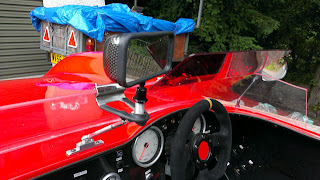ECU re-mapping
The J15 I have just built uses a Puma 1.7 vvti engine designed by Yamaha. I stuck with the Ford ecu to keep costs down and hoped to inherit the reliability of the original ford package. I have however uprated the engine with cams, Racing Puma plenum, ported the head and fitted a lightened flywheel with a racing clutch.
A chap called Nik from Sitec did the mechanical work a year and a half ago. He still worked at Sitec when I took the engine back to have the ecu remapped. He handed the rolling road work to Ross and we started to make enquiries at a company called PumaSpeed about uprating the ecu to a racing puma spec. It turns out there is a limited amount you can do to the Ford ecu's as they only allow you into an ram update area but you can however change a number of key things to improve the torque at low revs which is the inherent problem with the standard package. We changed the timing, fuelling and disabled the torque limiter.
The problem with the DUDE ecu that came with the original donor car was that no one could uprate it to the desired Racing Puma spec. That is because it was an early ecu from 1997 and could not be uprated to a racing puma spec. It does not appear to have the update area.
My understanding is Ford only ever kept one ecu for the ford Puma range and when the electronics package was uprated the ecu was backwards compatible with older harnesses/engines. If you asked ford for a new ecu for an older engine Ford then re-flashed the ecu to match the engine spec.
I managed to obtain a newer ecu from a 2001 car which had an identical spec to my original donor car. It came complete with a lock barrel and key.
There is someone on ebay currently publishing a cross reference from Coded ECU to Ford
part No:
97FB-12A850-HB (DUDE) My original Puma 1997
97FB-12A650-TA
(PEST)
97BP-12A650-KA(????)
98FB-12A650-HC
(MUFF)
XS6F-12A650-AHB (TAPE)
XS6F-12A650-APA
(TEAT)
1S6F-12A650-HA
(DIVE) The 2001 I obtained from ebay
It turns out that about the year 2000 they went
from a single Oxygen sensor to dual sensors (one before and after the cat).
This was a mandatory EU change to put on a light if the cat efficiency
dropped be low an acceptable level. Puma speed informed me despite that change it would work with my harness.
My original DUDE ecu from Puma
R873 CGB extract from Ford ETIS
29.08.1997
Vehicle Line: Puma
1997-2001
Body Style: 3 Door Coupe
Engine: Zetec 1.7
EFI
Transmission: 5 Speed Manual Transaxle - B5/IB5
Drive: RHD
FWD
Axle Ratio: 3.82
Emission: EEC 96 Car (EEC 1)
Air
Conditioning: Manual Air Conditioning
Territory: (+)"GB"
Paint:
Panther Black (Metallic)
Interior Colour: Alchemy Interior
Interior
Fabric: Silverstone/Echo
The markings on the side of the DIVE ECU
from ebay:
Reg X774 OAC extract from Ford
ETIS
10.01.2001
Vehicle Line: Puma 1997-2001
Body Style: 3 Door
Coupe
Version: Series 10
Engine: Zetec 1.7 EFI
Transmission: 5
Speed Manual Transaxle - B5/IB5
Drive: RHD FWD
Axle Ratio:
3.82
Emission: 2000 EEC (EEC 7)
Air Conditioning: Manual Air
Conditioning
Territory: (+)"GB"
Paint: Panther Black
(Metallic)
Interior Colour: Medium Dark Graphite
Interior Fabric:
Chrome/Twill
The trick is when you obtain an ecu from ebay it is advisable to get a key and lock barrel to match. This is to get PATS system to recognise the new key while keeping the steering lock functional. Failure to do this takes you into uncharted territory as far as I can understand.
The resulting engine power was about +17bhp from the original ECU but although the torque at lower speeds was improved immensely the overall power was a bit disappointing at 112bhp. There is obviously something wrong I will publish the final torque curve when I figure out what is wrong.
 |
| Original plot with DIVE |
 |
| Ross |
 |
| Nick and Ross after tuning |
Contents
http://sylvabuild.blogspot.co.uk/2012/01/sylva-j15-is-kit-car-designed-by-jeremy.html






















































